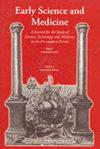用笛卡儿自然哲学解释占星术的影响:彼得·梅格林的《笛卡儿占星术》手稿(ASHB1530,约1680)
IF 0.5
2区 哲学
Q3 HISTORY & PHILOSOPHY OF SCIENCE
引用次数: 0
摘要
远距离行动是占星术的主要特征之一。占星术曾经是一门蓬勃发展的学科,但在现代早期却陷入了一场危机,最终导致其被学术界边缘化。占星术的批评者对所谓的远距离占星术行为的因果过程提出了质疑,传统上这种行为是基于天体发出的光,否认光可能是占星术影响的渠道。作为对这些批评的回应,一些占星家试图基于不同的理论和自然哲学基础来解释占星术的影响,例如,通过使用笛卡尔主义。本文聚焦于巴塞尔教授、德国天文学家、数学家和占星家Peter Megerlin(1623–1686)迄今未发表的手稿Laurenziana ASHB1530,Astrologia Cartesiana。它展示了Megerlin在处理占星术的自然哲学基础时对笛卡尔元素的兼收并蓄的使用,特别注意他试图解释占星术对微粒子学的影响。这也有助于重建Megerlin的传记和学术形象,重点是他在17世纪巴塞尔参与哥白尼宇宙学和占星术的意义。本文章由计算机程序翻译,如有差异,请以英文原文为准。
Explaining Astrological Influence with Cartesian Natural Philosophy: Peter Megerlin’s Manuscript Astrologia Cartesiana (ASHB1530, circa 1680)
Action at a distance was one of the key features of astrology. Once a thriving discipline, astrology in the early modern period entered a crisis that ultimately culminated in its marginalization from the domain of scholarly recognition. Critics of astrology took issue, among other things, with the causative process of the supposed astrological action at a distance – traditionally based on the light shed by celestial bodies – denying that light could be a conduit of astrological influence. In response to such criticisms, some astrologers attempted to explain astrological influence based on different theoretical and natural-philosophical foundations, as, for instance, by employing Cartesianism. This paper focuses on the so far-unpublished manuscript Laurenziana ASHB1530, Astrologia Cartesiana, by the German astronomer, mathematician and astrologer Peter Megerlin (1623–1686), a professor in Basel. It shows Megerlin’s eclectic use of Cartesian elements in his treatment of the natural-philosophical bases of astrology, paying particular attention to his attempt to explain astrological influence on corpuscularian grounds. It also contributes to the reconstruction of Megerlin’s biographical and scholarly profile, focusing on the significance of his engagement with Copernican cosmology and astrology in seventeenth-century Basel.
求助全文
通过发布文献求助,成功后即可免费获取论文全文。
去求助
来源期刊

Early Science and Medicine
HISTORY & PHILOSOPHY OF SCIENCE-
CiteScore
0.50
自引率
0.00%
发文量
22
审稿时长
>12 weeks
期刊介绍:
Early Science and Medicine (ESM) is a peer-reviewed international journal dedicated to the history of science, medicine and technology from the earliest times through to the end of the eighteenth century. The need to treat in a single journal all aspects of scientific activity and thought to the eighteenth century is due to two factors: to the continued importance of ancient sources throughout the Middle Ages and the early modern period, and to the comparably low degree of specialization and the high degree of disciplinary interdependence characterizing the period before the professionalization of science.
 求助内容:
求助内容: 应助结果提醒方式:
应助结果提醒方式:


